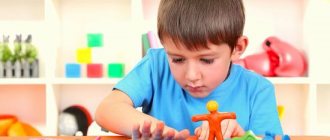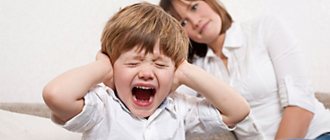Useful articles
Just like adults, adolescents can react very actively to stress that results from difficult life situations. Often, the first signs of the development of neurosis go unnoticed, since the teenager spends a significant part of his time outside the home (at school or in the company of friends). A child during puberty should be monitored especially closely, since the likelihood of developing nervous disorders is very high, and treatment of neurosis in adolescents should begin as early as possible.
What are neuroses in children
Neuroses in children and adolescents are a group of reversible borderline disorders of the nervous system that arise due to the influence of a psychotropic factor.
Traumatic factors include interpersonal and intrapersonal conflicts, stress, excessive mental and physical activity. Neuroses in children develop in 35% of all children attending preschool institutions. The largest number is observed in children of senior and primary school age, as well as preschool children, while it is more common among boys than among girls.
The manifestation of neuroses in children is mainly associated with a violation of the psycho-emotional sphere and occurs from 3-16 years. With the development of such a borderline state, there are no increasing changes in personality or dementia.
PsyAndNeuro.ru
Over the past ten years, several meta-analyses have been published summarizing the current knowledge of the treatment of anxiety disorders in children and adolescents, tolerability, predictors and moderators of treatment outcome, and risk factors.
RCTs published during the 10 years up to July 2021 on anxiety disorders in children and adolescents were selected for this review. Studies that used DSM-4 diagnostic categories classified PTSD as an anxiety disorder and did not always include separation anxiety disorder.
Anxiety disorders begin earlier than all other childhood mental illnesses, with a median age of onset of 6 years (depression 13 years, substance abuse disorders 15 years).
Specific phobias
Specific phobias are anxiety disorders that begin at a very early age (the average median age of onset is 6 years).
Separation anxiety disorder
The average age of onset of the disease is 8 years. In the United States, separation anxiety disorder occurs in 6.7% of children (more often in girls than boys). Separation anxiety disorder increases the risk of developing panic disorder later in life (hazard ratio, 3.5) and significantly increases the risk of generalized anxiety disorder (hazard ratio, 7.7).
Social anxiety disorder (SAD)
Behavioral inhibition is common in children with social anxiety disorder. The full onset of anxiety disorder symptoms occurs around age 12. Social anxiety disorder, which affects about 9% of adolescents, is associated with an increased risk of developing other anxiety disorders and school failure.
Generalized anxiety disorder (GAD)
As with most anxiety disorders, female gender increases the risk of GAD in post-puberty. Between the ages of 13 and 18, GAD occurs in 2.2% of adolescents.
Panic disorder (PD)
Panic disorder is the “last” childhood anxiety disorder in terms of developmental chronology. The incidence, as in the case of social anxiety disorder and GAD, increases in older age groups: 1.8% at the age of 13-14, 2.3% at the age of 15-16, 3.3% at the age of 17-18.
Agoraphobia
At the age of 13-17 it occurs in 2.5%.
The proportion of patients with severe anxiety (severe functional impairment or very severe distress) varies depending on diagnosis. Severe forms of PD, SAD, and GAD are more common in older children, affecting 8.3% of adolescents. Most adolescents with PD or agoraphobia experience severe anxiety; in the group of adolescents with GAD, severe anxiety occurs in half of the patients. In SAD, severe anxiety occurs in 14.3% of cases. In case of separation anxiety disorder, severe form of anxiety is observed in 7.9%, in case of specific phobias - <5%.
At present, it remains unclear how the combination of known environmental, biological, and developmental factors leads to anxiety disorders.
Cognitive risk factors
Cognitive risk factors for anxiety disorders include cognitive distortions associated with threat response, intolerance of uncertainty, and learned behavior (e.g., avoidance). Avoiding situations that provoke anxiety in a child or adolescent operates on the principle of negative reinforcement. Intolerance to uncertainty manifests itself in the tendency to react negatively (at the emotional, cognitive, behavioral level) to a state of uncertainty.
Behavioral inhibition as a risk factor
Behavioral inhibition - a feeling of depression that occurs when interacting with unfamiliar people or in unfamiliar circumstances - is observed in 15% of children and increases the risk of anxiety disorders (GAD, SAD, BD and separation anxiety disorder). Some studies, including meta-analyses, suggest that behavioral inhibition increases the risk of SAD the most (by a factor of 7); Almost half of children with behavioral inhibition develop SAD, and the risk does not depend on temperament or age. Certain aspects of behavioral inhibition—fear of adults—may be associated with the risk of separation anxiety disorder.
Family situation as a risk factor
Having a parent with GAD, parental separation, and a dysfunctional family (as measured by the McMaster Family Functioning Scale) significantly increases the risk of developing GAD. Events associated with separation from parents further increase the risk of anxiety disorders.
There is conflicting evidence regarding the influence of parental behavior. Some studies show that overprotective parenting increases the risk of anxiety. On the other hand, there are studies showing that the main influence on the risk of anxiety disorders is exerted by specific types of parental behavior that contribute to the formation of learned behavior patterns in the child. The EDSP program (“Early Stages of Psychopathology” - a prospective longitudinal study started in 1994 in Munich) did not reveal a link between excessive parental care and an increased risk of anxiety disorders. The parental model of anxious behavior contributes to the fact that children avoid new situations or treat them with increased caution.
Parental Anxiety Disorders
An anxiety disorder or certain personality disorders in a parent increases the risk of an anxiety disorder in a child. For example, parental GAD increases the risk of developing childhood GAD but does not affect the risk of depressive disorders. However, if a parent has an anxiety disorder as well as a depressive disorder, the child has an increased risk of an anxiety disorder, but without an increased risk of depression. In children of parents with symptoms of personality disorders of clusters A and C, symptoms of anxiety are more pronounced.
Substance use and risk of anxiety disorders
As with other risk factors, the association of substance use with the pathogenesis of anxiety disorders is difficult to judge from cross-sectional and prospective studies. There is evidence that alcohol use increases the severity of panic disorder symptoms in adolescents. In the group of older teenagers, the connection between panic attacks and the desire to drink alcohol is not confirmed, from which we can conclude that the hypothesis explaining the use of alcohol by adolescents to reduce panic attacks is weak.
In recent years, the connection between cannabis use and anxiety disorders has become clearer. Daily cannabis use during adolescence increases the risk of developing anxiety disorders even among those who have stopped using, which likely suggests long-term effects of cannabis on adolescent mental health. The use of synthetic cannabinoids is associated with a decrease in gray matter volume and changes in the activity of cortical structures involved in the pathophysiology of anxiety disorders. It remains unclear whether the use of other cannabinoids has the same effect and which specific psychoactive component is responsible.
Environmental pollution as a risk factor
Relatively few studies have focused on the effects of environmental pollution, particularly air pollution. Mercury and other toxic substances increase the risk of developing anxiety disorders. Increased concentrations of mercury in the mother's body at the time of birth increases the likelihood of a child being diagnosed with anxiety disorders at the age of 8 years. Vehicle pollution has also been linked to increased anxiety symptoms.
Compared to other groups of drugs, antidepressants have been studied best and have also shown the best effectiveness. The anti-anxiety effects of antidepressants support the recent shift in psychopharmacology from diagnosis-based terminology, often tied to the drug's first application, to NbN nomenclature based on mechanism of action and pharmacology.
SSRIs
SSRIs are most effective in treating childhood and adolescent anxiety disorders, but patients taking SSRIs discontinue treatment due to side effects more often than patients taking SSRIs. In addition, SSRIs are more likely than SSRIs to produce an stimulating effect in children and adolescents.
In the United States, SSRIs are most commonly prescribed for the treatment of anxiety disorders in children and adolescents. In approximately half of cases, treatment lasts at least 6 months. It is worth noting that nearly one in three non-adult patients with anxiety in the United States are treated with a non-SSRI drug.
Studies of the effect of SSRIs in child psychiatry in the treatment of anxiety disorders show that in 70% of those cases where improvement is recorded in the 8th week of treatment, it occurred earlier - within the first 4 weeks. Compared with SSRIs, improvement occurs more quickly, with trajectories of improvement diverging between SSRIs and SSRIs around the 4th week.
A meta-analysis on side effects showed that SSRIs are often interrupted due to side effects, which include agitation, sedation, insomnia, abdominal pain, and headache. Neither SSRIs nor SSRIs are associated with suicidality requiring emergency intervention. In the SSRI group, the meta-analysis found a difference in the risk of suicidality. The safest in this regard is sertraline.
SSRI
Two studies showed the effectiveness of venlafaxine in the treatment of GAD, one - in the treatment of SAD. One study showed the effectiveness of duloxetine in the treatment of GAD, and one study showed the effectiveness of atomoxetine in the treatment of ADHD with comorbid anxiety disorders.
TCA
Due to relatively poor tolerability, TCAs have given way to SSRIs and SSRIs. There is limited research on their effectiveness in treating anxiety disorders in children. A study showing the effectiveness of imipramine in the treatment of SAD was published quite a long time ago - in 1971.
Modulators 5-HT1A
Two 2021 studies showed no difference between the effects of buspirone and placebo in the treatment of GAD in a group of patients 6-17 years of age.
Alpha adrenergic agonists
A small 2021 study found that guanfacine was no different in treating anxiety disorders than placebo on the PARS (Pediatric Anxiety Rating Scale) and superior to placebo on the Clinical Global Impressions Scale (CGI-I). patient's condition).
Benzodiazepines
There is evidence supporting the use of benzodiazepines in the acute treatment of anxiety in children and adolescents, but studies of long-term use of benzodiazepines for the treatment of anxiety disorders in non-adults suggest no benefit. With regard to emergency suicidality, the risk of benzodiazepines in the treatment of anxiety disorders in children and adolescents was demonstrated in a 2021 meta-analysis. However, the results of this meta-analysis depend significantly on one small RCT from 1994, so there remains a need for more research.
Several recent studies in child psychiatry have shown that benzodiazepines as an adjunct to primary treatment—at least for treatment-resistant depression—impair treatment tolerance and presumably increase the risk of suicidal events (suicidal ideation, self-harm, suicide attempts).
Combination of SSRIs with psychotherapy
For the treatment of anxiety disorders in child psychiatry, experts recommend a combination of SSRIs + psychotherapy (CBT). However, the effectiveness of this combination has been studied in relatively few studies.
The largest study of the effectiveness of SSRIs in the treatment of anxiety in children, CAMS (“Child/Adolescent Multimodal Anxiety Study,” 2008), showed that the combination of CBT + sertraline was more effective than psychotherapy or sertraline alone.
More than 20 RCTs suggest the benefits of CBT in treating childhood anxiety disorders. Recommendations of CBT as a first-line treatment are based on the accumulated evidence of effectiveness, the limited nature of side effects, and the willingness of the patient and his family to psychosocial therapy. It is important to remember that there is a gap between the conditions in which psychotherapy is practiced during research and the conditions in everyday life. In particular, this concerns adherence to treatment in the form of exposure therapy - this component is better in research groups than in clinical practice.
Author of the translation: Filippov D.S.
Source: Strawn, JR, Lu, L., Peris, T.S., Levine, A. and Walkup, J.T. (2020), Research Review: Pediatric anxiety disorders – what have we learned in the last 10 years? Journal of Child Psychology and Psychiatry
Causes of neuroses in children
The causes of neuroses in children are very diverse, but the most common are family-related ones. Often, conflicts within the home, disharmony in the family, emotional stress and formed mental trauma lead to the state of “neurosis in a child.” Symptoms develop due to the inability of the baby to survive this situation.
The causes of neuroses in children can also arise from intrapersonal conflicts, when there is a contradiction between drives and prohibitive actions. Perhaps neuroses in children arise as a defensive reaction to stress in the body.
Factors that form neuroses in adolescents include psychological predisposition. Certain personality traits, for example, the hysterical type, can shape the development of changes in the nervous system in unfavorable social conditions.
Neuroses in preschool children are often formed as a result of hereditary factors, injuries and diseases. The course of childbirth and pregnancy also plays a big role in defining the concept of neurosis in a child. Symptoms depend on the cause, conditions, age and rate of development of the condition.
The most common problems in childhood and adolescence include:
- headaches in adolescents;
- dizziness;
- back pain;
- sleep disorders;
- apathy, lethargy and reluctance to do anything;
- irritability;
- increased feeling of anxiety.
Often the above conditions are interrelated, and they cannot be simply explained by “transitional age.” Frequent headaches in a teenager can cause irritability and apathy, which will negatively affect the educational process. Therefore, it is worth listening to the child’s complaints. Treatment of teenage headaches is necessary, but to understand the causes of the disease, it is worth visiting a consultation with a neurologist.
Headaches are the most common complaint among teenagers. All headaches can be divided into:
- primary (tension headaches, migraines);
- secondary (manifestations of another disease of the nervous system or a consequence of infectious diseases, high fever, pathology of the ENT organs, etc.).
Symptoms of neuroses in children
Neuroses in children have their own characteristics.
They are incomplete, residual with a predominance of somatovegetative disorders.
We can distinguish several groups of obsessions (thoughts, fears, actions), supervaluable ones (fears, ideas), and rituals. Obsessions are pathological fears, thoughts, actions that arise against his will.
The main children's fears include fear of the dark, ugliness (especially in teenage girls), loneliness, etc. The main periods of obsession will be 3, 7, 11-13 years.
Supervaluable ideas, fears, are ideas that stand at the head of all others. For example, fear of death. The child does everything to avoid getting sick, dying, and may be delusional.
Rituals are a child’s perverted reaction to stress with the formation of a defensive reaction in the form of a reflex. For example, before falling asleep, a child checks what is under the sofa, while dropping the handle (on purpose from time to time). The rituals are performed according to the planned plan.
All this is neurosis in a child.
Symptoms can occur at any age, and are preceded by some kind of traumatic situation. Neuroses in children can be accompanied by hysterical fits, a complete lack of sonority of the voice, sudden short-term blindness, various pains throughout the body, limitation of movements, etc.
The manifestations of neuroses in children are different, but have similar causes and symptoms. Neuroses in adolescents can occur in the form of aggression towards oneself (suicide attempts, thoughts), as well as towards others.
How do childhood neuroses manifest?
Symptoms of childhood neurosis depend on the type of disorder:
Hysteria
. It manifests itself as increased sensitivity, impressionability, and suggestibility. The child develops selfishness and often experiences mood swings. When crying, affective-respiratory seizures develop, that is, holding the breath.
Neurasthenia
. The child becomes irritable, whiny, and reacts nervously to the slightest stimuli. Fatigue increases, he becomes inattentive, and cannot concentrate on school or other activities. Symptoms are often accompanied by a squeezing headache.
Obsessive-compulsive disorder
. The child becomes unsure of himself, indecisive and fearful. Fears of loneliness, darkness, insects, animals or other factors appear. So-called ritual actions may appear - constant hand washing, movements that are repeated a certain number of times, which are accompanied by a nervous tic.
Treatment of neuroses in children
Neuroses in children should be corrected under the supervision of a neurologist, since such a condition can provoke the development of mental illness.
All conditions associated with behavioral disorders, hysterical states, sudden deterioration of the condition (pain, short-term loss of vision, movement disorders), pathological habitual movements (children's tics) require treatment. Neuroses in children are treated with medication.
The observation is also carried out by a psychiatrist, since neurosis can serve as an initial symptom of another disease. Neuroses in preschool children require close attention from parents, since the main cause is related to the family environment or the environment of a preschool institution.
Physiotherapeutic treatment is carried out. Neuroses in children respond well to physiotherapy methods; a positive effect from TCMT (transcranial magnetic therapy) has been found.
Advantages of treating childhood neuroses in our clinic
- We use safe methods
. We prescribe medications that are safe for children. We select psychotherapy methods designed for children’s perceptions and treat them in a playful way. - We discuss treatment with parents
. We talk about the upcoming treatment, possible risks and complications. If parents are against medications, we discuss the possibility of psychotherapeutic treatment. - We provide consultations with parents
. We conduct sessions with a psychotherapist in the presence of parents to reduce stress for the child. - We issue certificates to the school
. If the child does not attend school during treatment, we provide a certificate.
You can find out more about how our child psychiatrist conducts consultations here.
To make an appointment for your child at the ROSA clinic, call. You can ask your doctor questions online using the feedback form at the top.
Prevention of neuroses in children
It comes down to reducing the child’s physical and mental stress, creating a favorable home environment, the baby’s positive emotions will help cope with the illness. Neuroses in adolescents are prevented through long conversations with a psychologist and parents.
If prevention is not carried out correctly and the symptoms continue to increase, then this condition requires treatment. Neuroses in children can lead to maladaptation of the child in the team. Neuroses in adolescents are associated with the desire for perfection, youthful maximalism and require understanding from parents.
Where can I go for help?
Our Center offers assistance from qualified child psychiatrists. If you think that your child has neurasthenia, please consult our specialists. Neurasthenia is a diagnosis made by a doctor.
At the appointment, the doctor analyzes the situation in the family, collects a complete history of the disease, and identifies predisposing indicators. To achieve positive treatment results, an integrated approach is used. First of all, it is necessary to get rid of the traumatic factor, then reduce physical and psychological stress.
You can make an appointment with a child psychiatrist in Saratov from 8.00 to 20.00 by calling (8452) 244-000. Reception is by appointment only.
Prevention of vegetative-vascular dystonia in children and adolescents
Vegetative-vascular dystonia in adolescents and young children can be practically asymptomatic, especially if adults pay due attention to the prevention of VSD.
We are talking about leading a healthy lifestyle, playing sports at both an amateur and professional level, diet, as well as sleep and wakefulness. For better vascular condition, it is necessary to diversify your diet by adding more fiber and vitamins, as well as foods containing potassium and magnesium. But it is better to exclude fatty and fried foods or at least reduce their consumption to a minimum. The reason for avoiding thermally processed fats is the risk of developing atherosclerotic processes. Naturally, during this period it is best to increase the child’s time in the fresh air.







